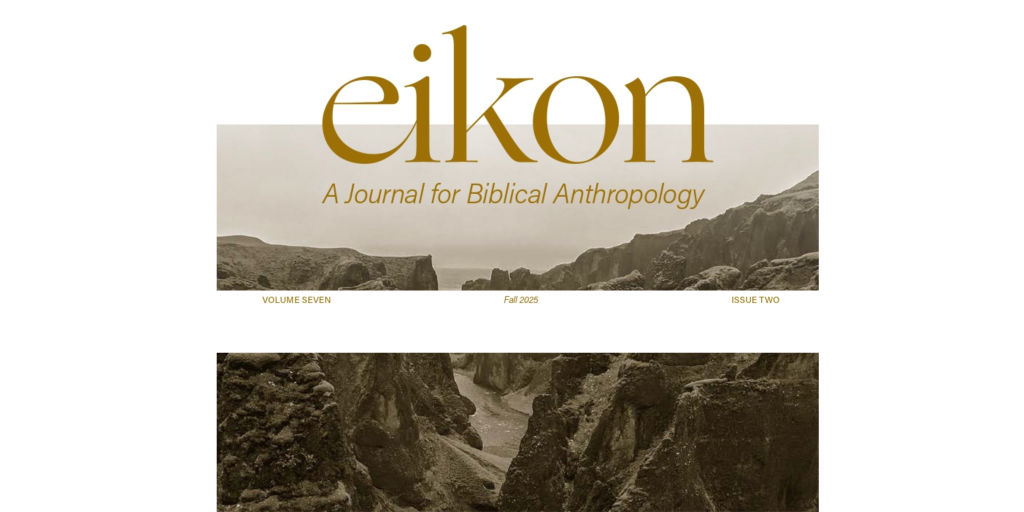
Editor’s Note: The following forum contribution appears in the Fall 2025 issue of Eikon.
What, in a nutshell, is the image of God? In the past, a majority of Christians have taken the view that since God is invisible (John 4:24), humanity does not resemble God physically, but rather in terms of morality, personality, reason, and spirituality. This interpretation is inadequate because it is not based on the linguistic meaning of the fundamental text in Genesis 1 according to its ancient Near Eastern background:
26 And God said, “Let us make man in our image, according to our likeness, so that they may rule over the fish of the sea and over the birds of the sky and over the livestock and over all the earth and over every creeping thing that creeps on the earth.”
27 So God created man in his own image, in the image of God he created him; male and female he created them.
Let us immediately notice two things: (1) the grammar in Hebrew makes plain (as the translation above shows), that “ruling” is a result of the image and not the essence of the image; (2) the last two clauses of v. 27 are comments on the first sentence “God created man in his own image” and prepare the reader for the commands given in v. 28 (a) to reproduce and (b) to rule. The literary structure is as follows:
God created mankind in his image according to his likeness:
A in the image of God he created him
B male and female he created them
======
B’ be fruitful and increase in number
and fill the earth
A’ and subdue it
and rule over the fish/birds/animals
Thus, binary sexuality (i.e. duality of gender) is the basis for being fruitful, while the divine image is correlated with the command to rule as God’s regent. These observations from the literary structure are crucial. They are decisive in showing that the divine image is not to be explained in terms of the duality of gender in humanity.
We are now in a position to explain the meaning of the clause in 1:26a, “let us make man in our image, according to our likeness.” First, “the image of god” in the culture and language of the ancient Near East in the fifteenth century B.C. would have communicated two main ideas: (1) royalty and (2) sonship. The king is the image of god because he has a relationship to the deity as the son of god and a relationship to the world as ruler for the god. These relationships would have been understood as covenantal relationships. We ought to assume that the meaning in the Bible is identical or at least similar, unless the biblical text clearly distinguishes its meaning from the surrounding culture.[1] Second, this corresponds well with how Moses is using these terms in the creation account. In what follows, the exegetical microscope will focus on (1) the meaning of the words “image” and “likeness,” and (2) the exact force of the prepositions “in” and “according to.”
Likeness and Image in the Bible
The word “image” in Hebrew and Aramaic always refers to a physical image or statue in all but two instances, which are abstract and nonconcrete.
The word “likeness” is apparently synonymous, but focuses on how something compares, is like, or resembles the original. It is never used of a statue.
Although “image” and “likeness” are synonyms, each word carries a slightly distinct emphasis. The word “likeness” focuses on the relationship of the copy to the original while the term “image” focuses on how the copy represents the original to others. This is quite clear in the Bible in Ezekiel 23:15, the only other place besides Genesis where the two words occur together.[2] Moreover, the commentary in Psalm 8 consistently employs royal language to explain Genesis 1:26.
The ancient Near Eastern data correspond to the use in the biblical text. The word “likeness” in Genesis is closely associated with the creation of the human race, human genealogy, and sonship. It occurs in Genesis 1:26 in the creation of humans and again in 5:1, when this is recapitulated under the heading “Birth History of Humankind.” The third use is in 5:3 with the generation of Seth. Luke 3:38 interprets the “likeness of God” in Genesis to indicate that Adam is the son of God. Israel inherits the role of Adam and Eve and is specifically called the son of God (Ex. 4:22, 23).
Ten times prior to Genesis 1:26 we are told that grasses or fruit trees produce according to their kind or that God created creatures according to their kind. The implication is first that Seth belongs to Adam’s kind as a human being; and second, that some kind of kinship exists between humans and God.
The Prepositions “in” and “as” or “according to”
What is the exact force of the prepositions? In spite of the fact that the two prepositions are close in meaning, we must not assume that the meaning is identical. The best linguistic research reveals that the preposition bĕ = “in” indicates locative nearness or proximity while the preposition kĕ = “as” or “according to” emphasises something similar, yet distal and separate.
Putting the nouns and prepositions together, humans closely represent God in image, i.e., they represent his rule in the world. Humans are also similar to God in performing the action of creating human life, but not in the same way. Thus bĕ (in) emphasises a way in which humans are closely like God, kĕ (as, according to) a way in which humans are similar, but distinct. This interpretation also explains the reversal of the prepositions in Genesis 5:3. Seth shares precisely in the matter of generation and sonship, but is only similar and not identical in the representation of his father’s image.
The biblical account is both similar and different from the ancient Near Eastern context.
In Egypt, only the king is the image of god. In the Bible, all humans constitute the image of God. The covenant relationship between God and man is not restricted to an elite sector in society. The image applies to both male and female, since ’ādām is generic. Moreover, since the image describes the product and not the process of creation, it is ontological and structural, not just functional. We are hard-wired for relationship with God and with all creatures.
Summary
Humans have been given an absolutely unique place in creation. Genesis 1:26 defines a divine-human relationship with two dimensions, one vertical and one horizontal. First, it defines human ontology in terms of a covenant relationship between God and humans, and second, it defines a covenant relationship between humans and the earth. The relationship between humans and God is best captured by the term (obedient) sonship. The relationship between humans and the creation may be expressed by the terms kingship and servanthood, or better, servant kingship. This is supported by Ephesians 4 and Colossians 3 where Paul is describing the restoration of a covenant relationship with God, not faculties in humanity where we are like God.
You can read the other contributions to this forum “On the Image of God” by clicking on the links below:
[1] For a more in-depth treatment of the ancient near Eastern background and its correspondence with the creation account in Genesis, see Peter Gentry, “Humanity as the Divine Image in Genesis 1:26–28,” Eikon: A Journal for Biblical Anthropology 2.1 (Spring 2020), 56–70; Peter J. Gentry, “Humanity as the Divine Image in Genesis 1:26-28,” in Biblical Studies, Vol. 1 by Peter J. Gentry (Peterborough: H&E, 2020), 1–23.
[2] These two words also occur In the ancient Near Eastern Tell Fakhariyeh Inscription, a ninth century B.C. Aramaic text. In the Inscription the word “likeness” focuses on the king as a suppliant and worshipper of his god and communicates sonship while “image” focuses on the majesty and power of the king in relation to his subjects.
Share This Article


